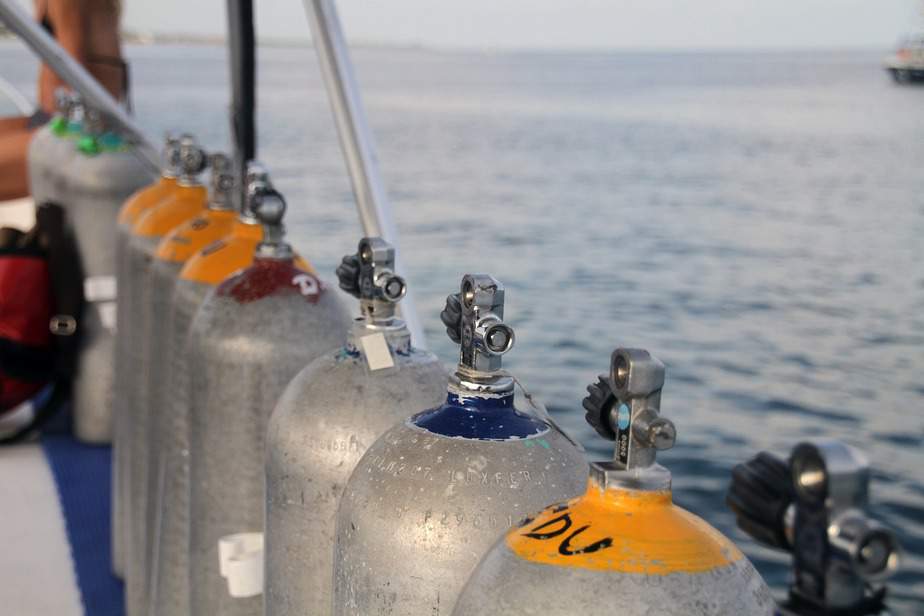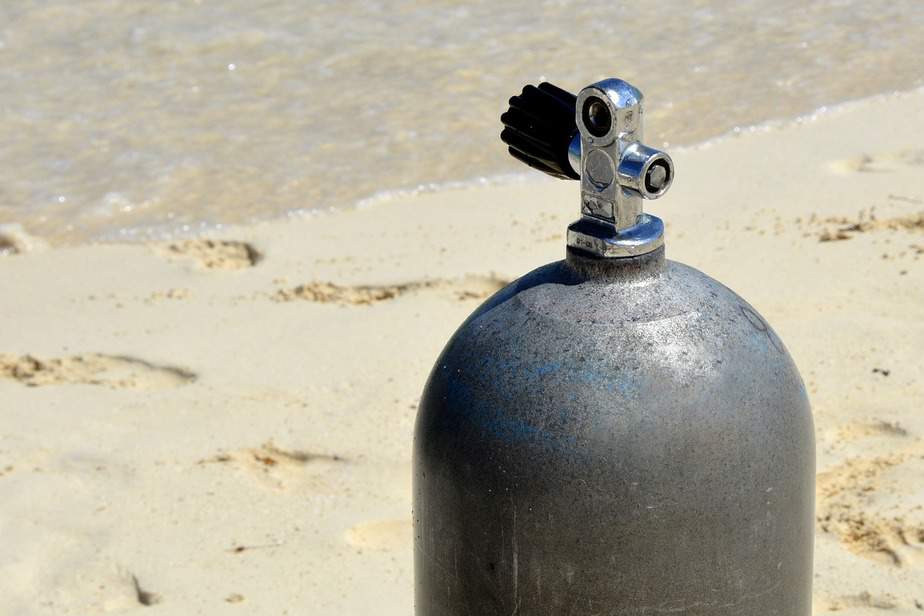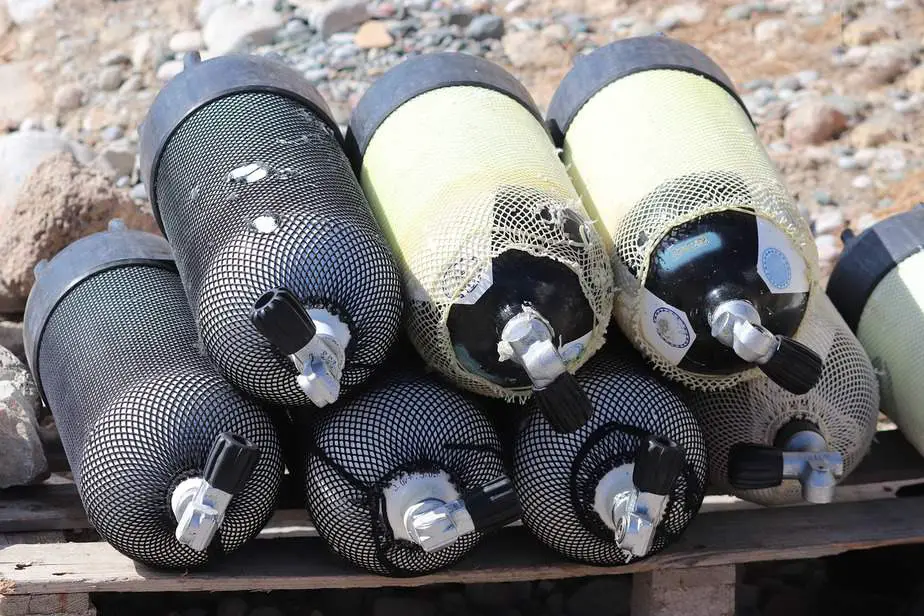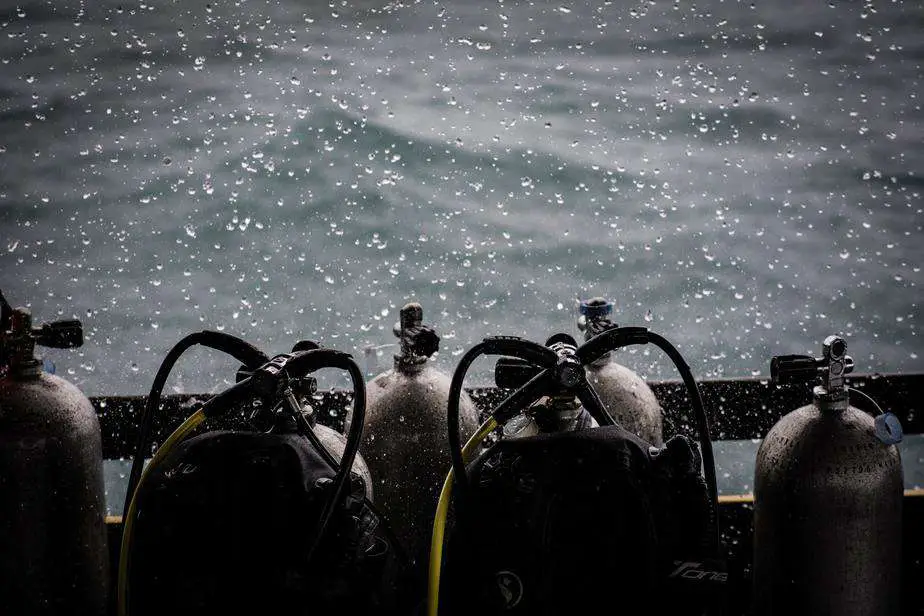Perhaps you haven’t gone scuba diving in a long time or you have since upgraded to new gear but haven’t gotten rid of the old one, but now you want to do something about it. Today, our focus is on scuba tanks; what do you do if you have a few lying around?
Since scuba tanks have a long lifespan, particularly steel tanks, there is a very good possibility that it is still usable and you can confirm this by hydro testing it. If it passes, then you can continue to use it or sell it if you want to get rid of it. If it fails the hydro test, then you can scrap it or you can cut it open and use the material for a DIY project such as turning it into a grill or some kind of art project.
In this article, we’ll discuss what you can do with your old scuba cylinders. If you think they’re still good, then don’t waste them. You might still be able to use it yourself, be it scuba diving for other hobbies such as airsoft, or you can sell it. To that end, we’ll also provide tips on how to sell your scuba tanks or how to scrap it to recoup some of the costs.
Confirm that the tank is still usable

Hopefully you took good care of your tank before you stored it. The common wisdom is to keep some pressure in the tank, say 200 psi, and this keeps moisture out and reduces the chances of internal corrosion. Hopefully, this is what you did before storing your scuba tank.
Conversely, a full tank can increase the chances of internal rusting, and the immense pressure of the gas on the scuba cylinder can wear down the material and compromise its integrity if it is stored for longer than 3 months. An empty tank will also allow moisture to form inside and cause internal corrosion. If your tank is full or completely empty, then there is some cause for concern.
You should also store your tanks vertically, preferably in a tank holder so it won’t fall down. The reason for this suggestion is that if moisture ends up forming in the tank, it will form in the bottom (or slide to the bottom) where the material is at its thickest. If the sides have rusted, then it may no longer have the integrity to safely store gas at its listed pressure rating.
If you have an old tank lying around and you aren’t sure if it’s good, it’s time to do a quick inspection.
First, look for signs of external damage. Is it banged up pretty good with dents and deep scratches, or if you notice any dreaded rust, then it is unlikely to pass inspection. Just skip to the next section on scrapping it. Remember to remove the boot and inspect the bottom of the tank for damage as well.
Next, inspect the valve for signs of failure. They are typically made of brass and covered with chrome, so it is not very durable and it’s pretty easy to tell if it’s been dinged up. A dropped cylinder is also unlikely to pass inspection.
Finally, check if the valve opens smoothly. If it’s stiff, it may need to be serviced, which can cost around $25. If the valve doesn’t open, then you can’t even tell if the tank has air inside. You may need to replace the valve, and this can cost around $60.
You might not even want to spend the money on these repairs, and the hydro test itself also costs money, so you might just want to scrap it all.
However, if a tank passes your own inspection and you feel that it might still be in good condition, then send it in for a hydro test. Seriously, the age of the tank is not an issue. There are steel tanks that are probably older than you that are still in service, so it’s worth a shot.
If the tank has failed the hydro test or you deem that it’s not even worth paying for a hydro test, then here are some of your options.
Scrap it

Note: Before scrapping or donating it, remove the tank’s valve. Tank valves that are in good condition are always valuable in that they can be re-used or sold as well. Even if the valve is no longer in good condition, you need to remove it anyways before scrapping or shipping the tank.
Don’t toss out your old tank just yet! It still might be worth some cash in the form of its metal scrap value.
A standard 80 cu/ft tank weighs approximately 31 lbs empty. That’s 31 lbs of aluminum, multiplied by what aluminum is worth per lb. Let’s say it’s currently worth $0.75/lb. So 31 * 0.75 = $23.25. Your rates may vary, but in this example, an aluminum cylinder without a tank valve can still net you over 20 bucks. This is significantly less than what you paid for, but at least you’re getting some value back.
What about a steel cylinder? Again, determine its weight – it should weigh approximately 35 lbs empty. Let’s say steel scrap is worth $0.20/lb. So 35 * 0.2 = $7.00. You can expect to get around $7 for a steel scuba tank (without the tank valve).
Unfortunately, if you had to pay for a hydrostatic test only to determine the tank failed it, then you still wouldn’t be able to recoup the cost you paid for the test but at least you can offset some of its cost. Thus, if you want to make a profit, you need to be relatively certain that it’s going to be condemned and so you can scrap it immediately.
Donate it
You can donate your old scuba tank to an instructor/dive shop. A condemned tank can still be of service as an example of a faulty tank. Cut the tank in half and donate it as a teaching aid. That way, students can get a clear look at what’s going on inside the tank and how thick the walls are.
Whether your tank has rusted only a little bit or significantly, or if it has substantial pitting, the instructor can at least turn your neglect into a valuable teaching tool to show the consequences of poor tank maintenance.
Dive shops also might have a method of disposing of old scuba tanks, so they can tank it off your hands; either way, it’s not your problem anymore.
Turn it into an art project
If you have tools and the DIY know-how, you can use your old scuba tank for material on an art project. It can be painted, cut up, or polished for whatever you want. Here are some ideas – doorstop, barbecue grill, lamp base, or vase; it can even be used as a planter for divers who also have a green thumb.
Use it or keep it around as back-up
Depending on your situation, you can still get some use out of your tank. If a hydro tested tank is obviously still valuable and you might want to sell it. That’s what the next section is all about. Or, you can continue to use it or keep it around as backup.
For instance, even if you lost your passion for diving, a scuba tank is still useful for storing compressed air so you can transfill other tanks such as a paintball gun tank. This way, you don’t need to buy a compressor and you can get it filled for cheap at a refill station, no license required for compressed air.
Alternatively, you can get it O2 cleaned and then filled with 100% oxygen. Then it can be kept on a boat as an emergency DCS kit and used by divers who are suffering the effects of decompression sickness. Get a cheap reg second-hand and get it O2 cleaned as well to pair with this tank.
Sell it

There are many ways to sell your scuba tank – list it online through eBay, Craigslist, or Facebook Marketplace, or do it in person via a garage sale. Either way, you’re going to meet up with someone at some point who’ll want to test out the tank.
There are a few things to keep in mind before listing your old scuba tank for sale. We have already touched on a few of these topics in the sections above, but for completeness’ sake, we will go over some of them again.
First, check if your scuba tank has an expired hydrostatic test marking. Hydro tests are good for 5 years, and the most recent hydrostatic pressure test date will be displayed on the tank itself so you don’t need a receipt to confirm it.
If a hydrostatic test was conducted within the last 2 years, it is still considered “fresh.” These are the same standards that a dive shop selling scuba tanks would adhere to. Any longer than that, and particularly if it is already expired, becomes a much harder sell.
Especially if it is expired, think about if from the buyer’s perspective – they are paying money for a tank that they will have to spend additional money on to get tested or fixed – they are taking on too much risk. Why wouldn’t they just buy a brand new tank? Heck, they might even settle for renting. As such, you will either struggle to sell, or they will haggle you down to basically nothing – you might be better off just scrapping the tank altogether.
Next, if your tank is aluminum, check if it’s older than 1990. Why that year specifically? Some manufacturers, mainly Luxfer and Walter Kidde, used a certain aluminum alloy (6351) in the construction of their tanks that is notorious for cracking. Buyers will want to know if the tank has passed an Eddy test (costs $20-30), and it’s yet another point that they might try to haggle down prices.
Furthermore, if you have a vintage steel 72 tank, does it have spray-in liner or coating inside? Manufacturers of these older tanks used to spray the inside with a coating that can come in different colors – typically light cream, but sometimes dark red or white. This coating can conceal defects and the coating itself can also deteriorate. Unless your steel 72 tank has a 3AA2250 marking, it will be harder to sell.
Summary
You got some old scuba tanks laying around the house? They aren’t worthless yet. You need to dispose of it the proper way. Even just scrapping it can get you some money back, so that’s probably the bare minimum amount of effort you should put in.
We discussed various ways you can inspect an old scuba tank on your own. It shouldn’t be too difficult to see if there is any external damage, but it can be harder to check for internal damage. Hopefully you kept some air inside the tank before storing it, because if the tank was completely empty, moisture could have gotten inside. Conversely, if it was full, then the pressure might have weakened the material and decreased its lifespan drastically.
If a tank is obviously damaged beyond repair, other than scrapping it, you can donate it as a teaching aid or turn it into a personal art project. Some divers have creatively turned their tank into things like a doorstop, planter, vase, and even a BBQ grill.
Assuming your tank is still in good condition, you can try selling it. Even if it failed its hydro test, it can possibly be sold to an instructor looking for an example of a poorly maintained tank to cut in half and show to their students. If you fail to sell it online, well, just scrap it then. Either way, you can recoup some of your costs.


